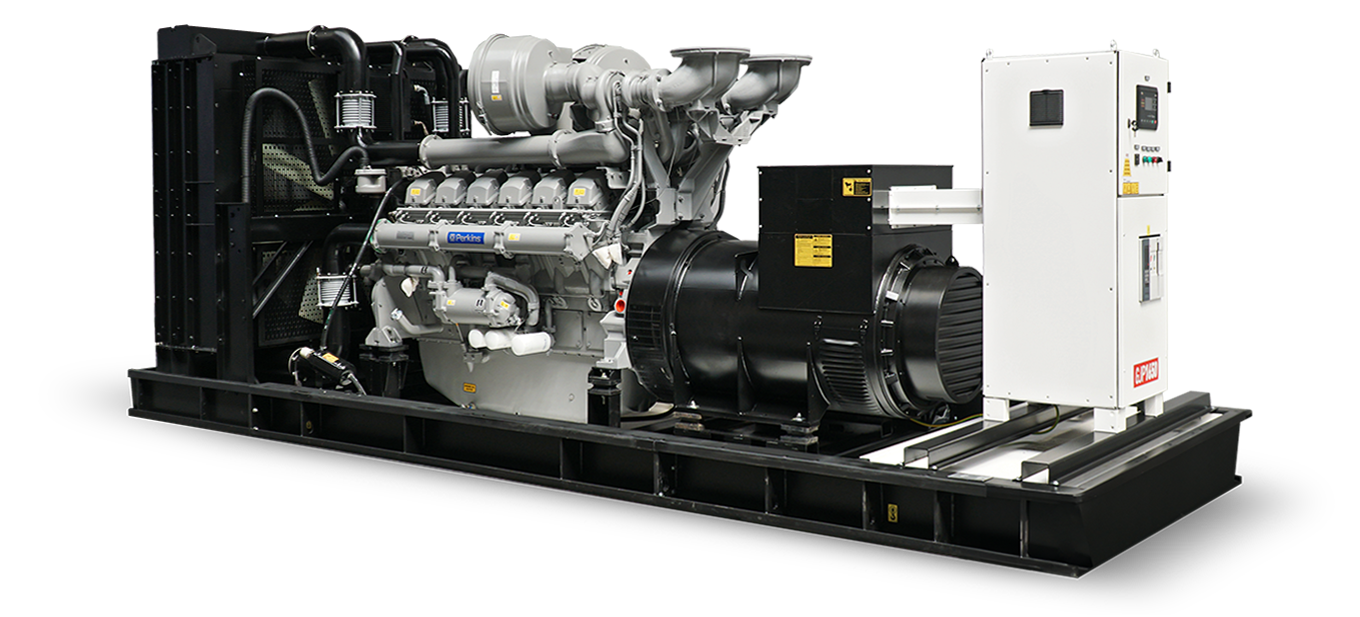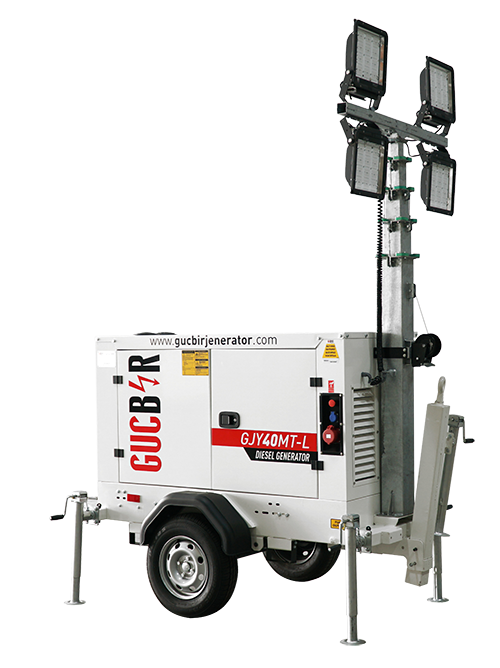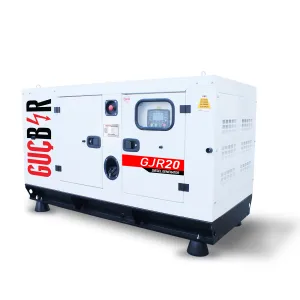Ways to Reduce Generator Noise Level
One of the most overlooked issues in large motor-driven equipment is the sound level. A sound wave can be defined as any disturbance propagating in an elastic medium such as a solid, liquid or gas. Noise is unwanted sound waves perceived by human hearing. People exposed to excessive noise for a long time may suffer hearing loss. Accordingly, excessive noise in an environment is a potential hazard.
Noise control involves three basic factors: sound, path and receiver. Before creating a solution to a complex noise problem, the dominant source of noise pollution should be identified, the characteristics of the transmission path should be explored and the noise level should be reduced to the permissible level.
During generator installation, many factors cause the actual Sound Power Levels (Sound Power Levels ‘SPL’: total sound emitted from a source relative to a reference power) to deviate from the predicted sound levels. The noise present in the environment prior to generator installation is referred to as ambient noise. The ambient or background noise must be measured and calculated before the installation of the device. If not all site conditions can be fully analysed, a safety tolerance must be applied to the calculated values. For example, buildings, walls and signage are common factors that change the sound field. Obstacles in the sound transmission path will partially reflect, absorb or transmit sound. It is important to study the site conditions and know the local noise laws before starting the generator project.
Sound waves should not only be considered in air, but also in solid and liquid media. Sound in air is usually generated by vibration in a solid or turbulence in a liquid. Sound waves in a solid or liquid travel long distances before they produce the sound that can be heard in air. An example of vibration noise is train sound waves travelling long distances over rails before being transmitted through the air. It is this type of sound transmission that makes it difficult to acoustically isolate generator sets. Without adequate vibration isolation at the generator base, the effect of vibration cannot be cancelled.
Ideally, the generators used should be mounted on isolators or on concrete with sound isolation enclosures surrounding the unit. Even small leaks in the system can affect the overall sound level. In order to prevent the noise produced by the fluids in the generator pipework, sound containment structures should be used to enclose these pipes.
Commonly Used Sound Absorption Materials
Sound waves are naturally reflected when they hit a hard surface. Mounting absorption surfaces on hard surfaces reduces the amount of reflected sound.
The vast majority of sound absorption compounds contain variable density materials that convert sound energy into heat through their pores. When researching a sound enclosure insulator, it is best to look for materials with air channels through which the sound wave can propagate. If the pores are closed, the material is usually a poor absorber. Any pores should not be closed by paint, coating or protective coating.
A few key points should be noted when starting the material evaluation process. The main criterion in sound absorption measurement is the ability to absorb energy, defined as the absorption coefficient. The absorption coefficient is mathematically defined as the ratio of the sound energy waves absorbed by a surface to the sound energy on the surface. The absorption coefficient can vary between 0 and 1. For example, if the coefficient = 0.8, 80% of the sound energy will be absorbed. Another way to examine sound coefficient levels is to look through an open door or window. This can be analysed as the ratio of the sound wave absorbed through the window opening (100% coefficient=1) to that reflected into the room. The absorption coefficient depends entirely on frequency and is analysed for either octave or 1/3 octave bands. Porous sound insulators are most efficient at high frequencies and can also increase low frequency absorption when the thickness or mass of the material is improved.
When low frequency sound absorption is required, the solution is usually the use of panel sound absorption materials. Thin, flexible panels should be mounted away from the wall with a shallow air gap between the two materials. The air gap between the panel and the wall is often conducive to low frequency sound absorption. Sound waves at the frequency of interest create a resonating effect through the air gap, causing the panel to vibrate. Only by filling the gap with a secondary porous material can the sharpness of the tuning be reduced.
The conventional approach to sound reduction uses a sound absorbing material sandwiched between the porous coating and the outer structure. The porous lining consists of a variety of materials with evenly distributed small pores that effectively absorb sound at the fundamental ‘tuning’ frequencies. Medium and large pores are used for low, high-pitched frequencies, but are not widely used. The porous surface is mounted on top of the sound absorbing porous material. Depending on the thickness, the gap and gap size increases the absorption of the whole structure at the main frequencies. Due to the reflection of solid surfaces, most high frequency sounds are significantly reduced using this system. A porous surface with a gap surrounding at least 20% of the entire material will not be able to significantly reduce the absorption of high frequency sounds. Any value above 20% is effective in the absorption of the entire sound.
Structures of Cabin Generator Sets
Mechanical data and exhaust data must be determined prior to the purchase of the cabin. This information is typically expressed in decibels at a predetermined distance. This data may include noise spectrum analysis. It is also important to include the radiator noise level.
It is important to recognise that for a given kW rating, dimensions, noise and airflow conditions vary from manufacturer to manufacturer. For example, an 800 kW generator from 2013 will not produce the same noise as an 800 kW generator from 2004. Each unit may contain some differences. If a cabinet is to be used to accommodate more than one set of generators, it is recommended that the worst case scenario be considered, whether it is a sound isolation cabinet or a protection cabinet against cavitation conditions.
Mass Law Basics
The law of mass refers to the transmission loss of particles in solid panels and for a limited frequency range the magnitude of the loss is completely controlled by the mass per unit area of the wall. The basic principle of the law of mass states that when the frequency is doubled, the transmission loss will increase by 6 decibels. For example, a sheet metal surface has a transmission loss of 13 dB at 63 Hz, 19 dB at 125 Hz and 25 dB at 250 Hz. When the thickness of the sheet metal is increased from 1/16 in. to 1/8 in., the transmission loss at 63 Hz becomes 13+6=19 dB. For this purpose, a composite layer is created using a combination of lightweight material and mass layers and the desired sound level is achieved.
Noise Resonance
All materials, whether man-made or natural, have a natural mode of vibration known as a resonant frequency.The resonance frequency formulation is based on many properties, including mass.Lightweight skid structures on the generator base can sometimes cause high noise levels due to vibration in the base caused by engine frequency waves.Choosing the appropriate vibration isolator is very important when choosing a generator.Good insulators have a serious effect in damping the motor force frequency and isolating other parts of the structure.
coatings
Most machine parts and multiple pipe systems are manufactured as standard with thermal insulator coatings to protect both personnel from burns and the machine from excessive heat loss.Large equipment, such as generators or turbines, require service connection pipe, which can be a source of intense noise. It is possible to provide both acoustic and thermal insulation with a single composite structure towards the outside of the pipe system or metal material.The most commonly used insulation materials in generators are foam composites or chemical sprays with which the piping system is painted.
Silencers / Noise silencers
The necessary way to control the sound coming from the engine, fan and blower are mufflers.Silencers are divided into 3 groups: reactive, absorptive and reactive/absorptive combination.Absorptive mufflers are good at high frequency sound reduction, while reactive mufflers are good at low frequency absorption.Eliminating a wide range of acoustic effects requires a system that includes both reactive and absorptive elements.Choosing a suitable silencer; It depends on different factors such as flow rate, noise spectrum, temperature, humidity.
Most Common Cabinet Groups
The most commonly used cabins in generators are acoustic cabins. Typical soundproofing generator cabinets are a multilayer structure consisting of a waterproof layer as well as porous sound absorption material facing the inside of the equipment.The main absorption layer is the waterproof layer, which blocks the passage through which the sound energy from the generator is transmitted.The porous sound absorption layer disperses the retained sound energy and provides heat-insulation feature.A typical soundproofing cabinet is maintained by hinged doors and air intake louvers.
Protective Cabins Against Normal Weather Conditions or Harsh Weather Conditions
In addition to sound insulation cabins, it should be determined whether a cabin for weather conditions is required. The main point here is whether the customer needs a cabin for normal weather conditions or for extreme weather conditions.If the customer only needs to protect the generator from weather conditions such as rain or snow, the solution is a normal weatherproof cabinet.
A full protective cabin is required for extreme weather conditions. In extreme weather conditions such as strong wind, excessive rainfall, seismic activity or extreme temperature, a fully protective cabin against harsh weather conditions should be used.Full protection; It means that the alternator or engine is not damaged in weather conditions such as rain, snow, sleet or hail.
Generator Cabin Construction
Generator cabinets; It is manufactured according to various preferences such as durability, sound insulation and cost.The most popular designs include:
Bolted – A simple generator cabinet; It consists of metal panels riveted or screwed together.
Welded – Welded with fabricated or structural metal members, the surface of the skeleton is covered with a metal sheet by means of bolts or rivets.
Prefabricated Panels – Panels come pre-fabricated and are assembled to form the roof and sides of the cabin.Suspended door assembly is utilized, wall and roof panels often include metal-faced thermal or acoustic insulation in the generator inner lining.
Generator Cabin Materials
When acquiring a generator cabinet, it is important to consider the best materials for the short and long term. The balancing factor between initial costs, generator geographic location, and long-term considerations regarding maintenance is important.See the table below for the most commonly used cabinet materials:
| Material | Features | shortcomings |
| painted steel | -low initial cost -conducive to noise reduction -resistant to damage | -high maintenance-weight |
| Coated steel (galvanized, aluminized) | -medium initial cost -more durable than painted steel -noise reduction -resistant to damage | -occasionally poor paint adhesion-weight |
| Factory-pre-painted coated steel | -reasonable initial cost -long life -good appearance | -painted surface semi-gloss-weight |
| Factory-prepainted aluminum | -excellent long-lasting-lightweight-aesthetic looking glossy surfaces | -higher initial cost than steel-need for additional mass for noise control with insulation |
| “300” Stainless steel | -resistance to harsh chemical environmental conditions -no paint required | -very high initial cost-“industrial” appearance-weight |
| “400” Stainless steel | -same as coated steel | -“silencer level” stainless requires high carbon content paint for good appearance and longevity -weight |
| Powder coated steel | -basically the same as coated steel-more color options than pre-painting-greater material thickness than pre-painting | -weight |
| Powder coated aluminum | -essentially the same as pre-painted aluminum but more resistant to corrosion | -cost |
Ses Azaltım Önerileri
One of the key points to consider when purchasing a generator is how much sound reduction is required. This decision is important to make when researching a generator as it will affect cabin size, air options and body materials. When performing a noise test, it is useful to know that the sound pressure unit measurement (decibel dB) is logarithmic.The basic principle can be related to the amount of sound reduction in a cabin.As the size, weight and air processing capacity of the generator increases, more sound insulation is required and the cost increases.
It is important to create an accurate table of noise requirements at the beginning of the generator project, rather than spending excessively on sound insulation.Most cities have guidelines on maximum sound levels in living spaces, but this is obscured by a noise source such as a standby generator set that operates once a month during maintenance or during power outages. It is important to learn maximum sound level laws before purchasing a generator cabinet.
Most diesel generators are used as standbys, and many municipalities have relaxed restrictions for standby units.These restrictions are stricter in generators used as prime or continuous power due to long-term use.If a certain sound level is desired in the living area, the cabin manufacturer must be informed about the requirement and the distance of the generator set from the living area.In addition, the cabinet maker must have knowledge of the layout of surrounding buildings, utilities and topography.For example, a large structure near the generator, wooded area around the site, or a hard surface parking lot greatly affects the transmission of sound, so a cabin design is required for the project.
A sound level meter (decibel meter) is a common device used to measure sound level.The sound level meter works through a microphone that measures sound pressure and an electronic circuit that converts this pressure to an SPL reading.A basic sound meter can calculate an instantaneous SPL, providing the ability to read the values.
A real-time sound analyzer is a multi-purpose sound measurement device that can measure various sound levels simultaneously using multiple processors. Audio features can be observed over the entire real-time spectrum of interest with a real-time audio analyzer without data loss.This analyzer can do the job of multiple sound level meters by measuring entire octave or 1/3 octave bands simultaneously instead of one octave band at a time.Other optional features of this analyzer include Fast Fourier Transform (FFT) measurements for discrete frequency analysis and loudness measurements using the sound intensity probe.
A word of caution for potential customers: Since sound is a wave phenomenon, there is an inverse square law to which the rule of thumb is applied to determine the effects of distance on sound level.The inverse square law simply states that for a sound source in free field conditions, the sound level will decrease by 6 dB for every doubling of distance from the source.For example; If the sound level is measured at 100 dB(A) in 50 steps, 94 dB(A) is measured in 100 steps.It is also important to note that the term “free space” does not start until you are within 30-50 feet of the generator.
Sound Reduction Classification
If there is no specific decibel level to be achieved at a given distance, it is common to specify a performance specification, which is achieved by determining the amount of attenuation required in the cabinet itself.That’s why cabin manufacturers standardize sound reduction amounts for certain distances.For example; A manufacturer should be able to state that a 25 dB(A) reduction in 10 steps is a 10 dB(A) reduction in 1 meter.This broad range of data generally refers to average values measured at various points around the generator cabin.
When examining generator cabinet designs, attention should be paid to whether they are designed in such a way that there is no point containing noise 3-5 db(A) above the promised value.For example, if the radiator discharge air is not treated properly, the noise level around the cabin will be unacceptably high, even if it meets the design criteria.







